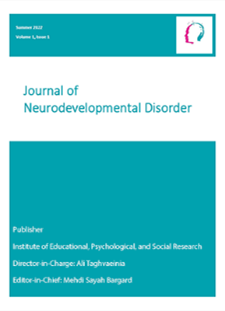The Effect of a Period of Basic Football Skills Training on Perceived Competence and Physical Abilities of Beginner Football Learners in Iraq: The Moderating Role of Age
Keywords:
basic football skills, perceived competence, physical abilities, children, quasi-experimental researchAbstract
Purpose: The purpose of the present study was to examine the effect of a period of basic football skills training on perceived competence and physical abilities among boys aged 9 to 12 years.
Methods and Materials: The research method was quasi-experimental with a pretest–posttest design and a control group. The statistical population consisted of elementary school boys and football school trainees in Maysan City, Iraq. From this population, 60 participants were purposefully selected and assigned to four groups: three experimental groups aged 9–10, 10–11, and 11–12 years (each consisting of 15 participants) who participated in the training protocol, and one control group (15 participants) who received no intervention. The mean age of the control group was 10.6 years, which was approximately in the middle of the experimental age range. The training protocol lasted eight weeks with three sessions per week and focused on basic football skills, including dribbling, passing, shooting, coordination, and small-sided games. The research instruments included the Perceived Physical Competence Scale for Children and a set of standardized physical fitness tests such as the Yo-Yo test, Sargent jump test, Illinois agility test, 20-meter sprint, and sit-and-reach test. Data were analyzed using analysis of covariance (ANCOVA) and Bonferroni post hoc tests.
Findings: The results showed that basic football skills training had a significant effect on perceived competence (F = 15.61, p < .001, η² = .31) and physical abilities (F = 18.92, p < .001, η² = .35). Moreover, the interaction effects indicated a moderating role of age, as children aged 11 to 12 demonstrated the greatest improvement compared to younger groups, while the control group exhibited minimal changes from the pretest.
Conclusion: These results underscore the importance of designing and implementing structured sports programs in schools and extracurricular contexts and can serve as an effective model for the holistic development of children during the critical ages of 9 to 12 years.
Downloads
References
Aghdasi, M. T., Behzadnia, B., & Mahdi Darvish Eldrisavi, H. (2024). Comparison of the effects of traditional teaching and small-sided games on the learning of fundamental football skills and the psychological needs of 11- and 12-year-old children. Mind, Movement and Behavior, 3(1), 19–34. https://doi.org/10.22034/mmbj.2023.58312.1055
Akbar, A., Abd Karim, Z., Syafitri, F. U., & Cahyani, F. I. (2025). Sports Psychology Perspectives on Cognitive Aspects in Shaping the Pathways of Young Football Players in Indonesia and Malaysia. Retos, 66, 1194–1205. https://doi.org/10.47197/retos.v66.111634
Al-Saeedi, A. H. A. (2025). Analytical Study of Physical Fitness Components for Football Juniors in Some Clubs in DhiQar Governorate. Sinar Sport Journal, 5(1), 13–13. https://penerbitadm.pubmedia.id/index.php/SSJ/article/view/2732
Basarir, B., Canli, U., Sendil, A. M., Alexe, C. I., Tomozei, R. A., Alexe, D. I., & Burchel, L. O. (2025). Effects of coordination-based training on preschool children's physical fitness, motor competence and inhibition control. BMC pediatrics, 25(1), 539. https://doi.org/10.1186/s12887-025-05897-x
Beyaz, O. (2025). The Effect of 32-Week Football Training on Body Mass Index and Motor Performances of Male Children Aged 8-10. Sport Mont, 23(1), 43–49. https://doi.org/10.26773/smj.250207
Çapo, E., & Baze, A. (2025). Age-Related Differences in Anthropometric and Motor Skill Development Among Youth Football Players: Implications for Tailored Training Programs. Innovative Technologies in Sport and Physical Activity, 9. https://www.researchgate.net/publication/393482874_Age-Related_Differences_in_Anthropometric_and_Motor_Skill_Development_Among_Youth_Football_Players_Implications_for_Tailored_Training_Programs
Costa, J. A., Vale, S., Cordovil, R., Rodrigues, L. P., Cardoso, V., Proença, R., & Seabra, A. (2024). A school-based physical activity intervention in primary school: effects on physical activity, sleep, aerobic fitness, and motor competence. Frontiers in Public Health, 12, 1365782. https://doi.org/10.3389/fpubh.2024.1365782
Dengel, D. R., Studee, H. R., Juckett, W. T., Bosch, T. A., Carbuhn, A. F., Stanforth, P. R., & Evanoff, N. G. (2024). Muscle-to-Bone Ratio in NCAA Division I Collegiate Football Players by Position. The Journal of Strength & Conditioning Research, 38(9), 1607–1612. https://doi.org/10.1519/JSC.0000000000004853
Duncan, M., Eyre, E. L., Noon, M., Morris, R., Thake, D., & Clarke, N. (2022). Fundamental movement skills and perceived competence, but not fitness, are the key factors associated with technical skill performance in boys who play grassroots soccer. Science and Medicine in Football, 6(2), 215–220. https://doi.org/10.1080/24733938.2021.1910332
Farley, J. B., O'Hara, M., Keogh, J. W., Woods, C. T., Rathbone, E., & Milne, N. (2024). Relationships between physical fitness characteristics, technical skill attributes, and sports injury in female Australian football players. PLoS One, 19(2), e0298267. https://doi.org/10.1371/journal.pone.0298267
Fifa. (2006). Football for the Future: Youth Training Manuals.
Fortunato, Á., Gonçalves, C., & Lopes, V. P. (2024). Relationship Between Motor Competence and Soccer-Specific Skills: A Longitudinal Study With Young Players. Journal of Motor Learning and Development, 1, 1–14. https://doi.org/10.1123/jmld.2023-0063
Gallahue, D. L., & Alsman, C. T. (2004). Understanding motor growth during different lifetimes. Bamdad Book Publishing. https://doi.org/10.5332/hatsuhatsu.2004.Supplement_15
Grygus, I., Gamma, T., Godlevskyi, P., Zhuk, M., & Zukow, W. (2024). Methodological aspects of developing motor skills in children of different ages during football club activities. Journal of Education, Health and Sport, 64, 55525–55525. https://doi.org/10.12775/JEHS.2024.64.55525
Hadavi, F. (2017). Development of ball-handling motor skills. Iran Textbook Publishing Company. https://dl.daneshchi.ir/file/chap-school/TMaharat-11-TB-Daneshchi.iR.pdf
Igamberdiev, O. (2024). Scientific and theoretical principles of the mechanism of training of football players with priority considering physical preparation. Mental Enlightenment Scientific-Methodological Journal, 5(08), 105–112. https://mentaljournal-jspu.uz/index.php/mesmj/article/view/680
Kokstejn, J., Grobar, M., Vampola, J., & Musalek, M. (2025). Why Motor Competence Matters: Fundamental Movement Skills and Their Role in Promoting Physical Activity and Health in Czech Children Aged 9-10 Years. Journal of Functional Morphology and Kinesiology, 10(3), 258. https://doi.org/10.3390/jfmk10030258
Kress, J., Bretz, K., Herrmann, C., Schuler, P., & Ferrari, I. (2024). Profiles of Primary School Children's Sports Participation and Their Motor Competencies. Children, 11(11), 1370. https://doi.org/10.3390/children11111370
Li, S., Li, H., Wang, B., Zeng, Z., Zhang, R., Yan, H., & Zhou, C. (2025). Effects of Recreational Football on Body Composition and Cardiometabolic Health in Overweight or Obese Individuals: A Systematic Review and Meta-Analysis. Life, 15(8), 1276. https://doi.org/10.3390/life15081276
Payne, V. G., & Isaacs, L. D. (2017). Human motor development: A lifespan approach. Routledge. https://doi.org/10.4324/9781315213040
Primasoni, N., Wahyuti, S. A., Arjuna, F., & Miftachurochmah, Y. (2024). The Effects of Football Training on Improving Aerobic Skills, Technique, and Anthropometry in Goalkeepers. Physical Education Theory and Methodology, 24(2), 237–244. https://doi.org/10.17309/tmfv.2024.2.07
Pyne, D. B., Gardner, A. S., Sheehan, K., & Hopkins, W. G. (2005). Fitness testing and career progression in AFL football. Journal of Science and Medicine in Sport, 8(3), 321–332. https://doi.org/10.1016/S1440-2440(05)80043-X
Reinhard, M. L., Mann, D. L., & Höner, O. (2025). The role of generic cognitive skills: an empirical investigation into the association between generic and sport-specific cognitive skills and playing level in youth football. Journal of Science and Medicine in Sport. https://doi.org/10.1016/j.jsams.2025.01.010
Rodrigues, L. P., Cordovil, R., Costa, J. A., Seabra, A., Guilherme, J., Vale, S., & Neto, C. (2025). Improving Motor Competence of Children: The "Super Quinas" Intervention Program in Portuguese Primary Schools. Journal of Physical Activity and Health, 22(4), 436–443. https://doi.org/10.1123/jpah.2024-0484
Sadeghi, N., Zamani Sani, S. H., & Hasanzadeh, N. (2019). The effect of psychological skills training on the psychological profile and performance of adolescent football players during the preparation stage. Sport Psychology, 4(1), 14–27. https://doi.org/10.29252/mbsp.4.1.14
Sargent, D. A. (1921). The physical test of a man. American Physical Education Review, 26(4), 188–194. https://doi.org/10.1080/23267224.1921.10650486
Sendil, A. M., Canli, U., Sheeha, B. B., Alkhamees, N. H., Batrakoulis, A., & Al-Mhanna, S. B. (2024). The effects of structured coordinative exercise protocol on physical fitness, motor competence and inhibitory control in preschool children. Scientific reports, 14(1), 28462. https://doi.org/10.1038/s41598-024-79811-3
Stamenkovic, S., Lilic, A., & Nikolic, D. (2024). The effects of an additional recreational football program on physical fitness in children - A review. Facta Universitatis, Series: Physical Education and Sport(1), 105–113. https://doi.org/10.22190/FUPES240903010S
Stefanica, V., Mercea, I. T., Ursu, V. E., Gorban, C. F., Dragos, C., Mihaiu, C., & Groza, G. G. (2024). Developing psychomotor skills and social attributes through integrated psychomotor and unified football training: A Special Olympics Intervention Study. Revista Romaneasca pentru Educatie Multidimensionala, 16(3), 224–242. https://doi.org/10.18662/rrem/16.3/892
Stoica, D., & Barbu, D. (2025). Analysis of Effects of Specific Football Training on the Development of Motor Skills in Juniors Aged 12-13 Years Old. Bulletin of the Transilvania University of Brasov. Series IX: Sciences of Human Kinetics, 101–108. https://doi.org/10.31926/but.shk.2025.18.67.1.12
Sun, Z., Liu, X., Fu, H., Shen, S., & Zhou, X. (2025). Comparisons of the anthropometric and physical characteristics of young elite Chinese male soccer players by age and playing position. BMC Sports Science, Medicine and Rehabilitation, 17(1), 22. https://doi.org/10.1186/s13102-025-01070-0
Tafuri, F., Romano, G., & Latino, F. (2025). Artificial Intelligence in the Improvement of the Athlete's Anatomical-Physiological Parameters: Transdisciplinary Pedagogical Models. Journal of Inclusive Methodology and Technology in Learning and Teaching, 5(1). https://www.inclusiveteaching.it/index.php/inclusiveteaching/article/view/276
Tokay, B., & Akil, M. (2025). "Creative dance and football" education program improves cognitive skills of 9-10-year-old school children. Research in Dance Education, 1–14. https://doi.org/10.1080/14647893.2025.2462531
Wang, J., Gao, S., Tian, J., Hong, H., & Zhou, C. (2025). The role of cerebellar-cortical connectivity in modulating attentional abilities: insight from football athletes. Behavioral and Brain Functions, 21(1), 9. https://doi.org/10.1186/s12993-025-00272-3
Wang, Y., Zhou, Z., Gao, Z., & Gu, Y. (2025). Comparative Effectiveness of Multi-Component, Exercise-Based Interventions for Preventing Soccer-Related Musculoskeletal Injuries: A Systematic Review and Meta-Analysis. Healthcare,
Wells, K. F., & Dillon, E. K. (1952). Sit and reach: A test of back and leg flexibility. Research Quarterly, 23, 115–118. https://doi.org/10.1080/10671188.1952.10761965
Williams, A. M., & Ford, P. R. (2008). Expertise and expert performance in sport. International Review of Sport and Exercise Psychology, 1(1), 4–18. https://doi.org/10.1080/17509840701836867
Zheng, W., Wang, W., Zhou, C., & Zhang, B. (2025). Promoting effects of campus football activities on the enhancement of adolescents' psychological qualities and the underlying mechanisms. Frontiers in psychology, 16, 1618503. https://doi.org/10.3389/fpsyg.2025.1618503
Downloads
Published
Submitted
Revised
Accepted
Issue
Section
License
Copyright (c) 2025 Mokdad Bashir Hussein Alsarki, Zahra Serjuei, Mohammed Hussein Hameedi Alsarkhi, Hamid Zahedi (Author)

This work is licensed under a Creative Commons Attribution-NonCommercial 4.0 International License.

